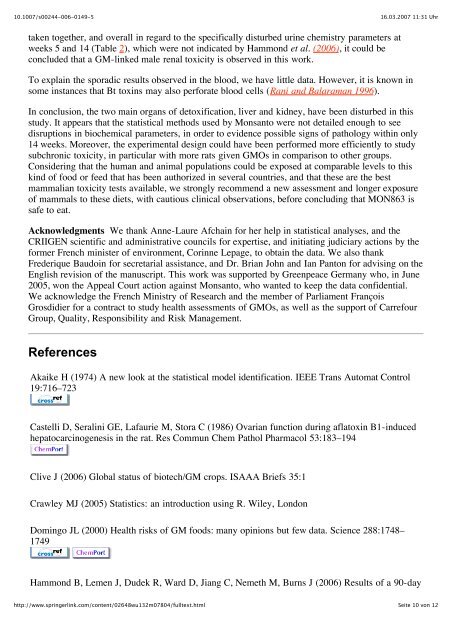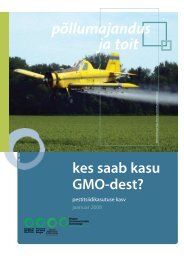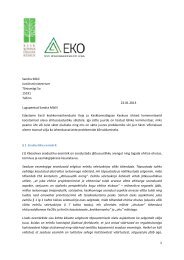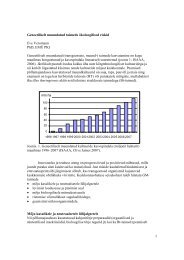New Analysis of a Rat Feeding Study with a Genetically Modified ...
New Analysis of a Rat Feeding Study with a Genetically Modified ...
New Analysis of a Rat Feeding Study with a Genetically Modified ...
You also want an ePaper? Increase the reach of your titles
YUMPU automatically turns print PDFs into web optimized ePapers that Google loves.
10.1007/s00244-006-0149-5<br />
16.03.2007 11:31 Uhr<br />
taken together, and overall in regard to the specifically disturbed urine chemistry parameters at<br />
weeks 5 and 14 (Table 2), which were not indicated by Hammond et al. (2006), it could be<br />
concluded that a GM-linked male renal toxicity is observed in this work.<br />
To explain the sporadic results observed in the blood, we have little data. However, it is known in<br />
some instances that Bt toxins may also perforate blood cells (Rani and Balaraman 1996).<br />
In conclusion, the two main organs <strong>of</strong> detoxification, liver and kidney, have been disturbed in this<br />
study. It appears that the statistical methods used by Monsanto were not detailed enough to see<br />
disruptions in biochemical parameters, in order to evidence possible signs <strong>of</strong> pathology <strong>with</strong>in only<br />
14 weeks. Moreover, the experimental design could have been performed more efficiently to study<br />
subchronic toxicity, in particular <strong>with</strong> more rats given GMOs in comparison to other groups.<br />
Considering that the human and animal populations could be exposed at comparable levels to this<br />
kind <strong>of</strong> food or feed that has been authorized in several countries, and that these are the best<br />
mammalian toxicity tests available, we strongly recommend a new assessment and longer exposure<br />
<strong>of</strong> mammals to these diets, <strong>with</strong> cautious clinical observations, before concluding that MON863 is<br />
safe to eat.<br />
Acknowledgments We thank Anne-Laure Afchain for her help in statistical analyses, and the<br />
CRIIGEN scientific and administrative councils for expertise, and initiating judiciary actions by the<br />
former French minister <strong>of</strong> environment, Corinne Lepage, to obtain the data. We also thank<br />
Frederique Baudoin for secretarial assistance, and Dr. Brian John and Ian Panton for advising on the<br />
English revision <strong>of</strong> the manuscript. This work was supported by Greenpeace Germany who, in June<br />
2005, won the Appeal Court action against Monsanto, who wanted to keep the data confidential.<br />
We acknowledge the French Ministry <strong>of</strong> Research and the member <strong>of</strong> Parliament François<br />
Grosdidier for a contract to study health assessments <strong>of</strong> GMOs, as well as the support <strong>of</strong> Carrefour<br />
Group, Quality, Responsibility and Risk Management.<br />
References<br />
Akaike H (1974) A new look at the statistical model identification. IEEE Trans Automat Control<br />
19:716–723<br />
Castelli D, Seralini GE, Lafaurie M, Stora C (1986) Ovarian function during aflatoxin B1-induced<br />
hepatocarcinogenesis in the rat. Res Commun Chem Pathol Pharmacol 53:183–194<br />
Clive J (2006) Global status <strong>of</strong> biotech/GM crops. ISAAA Briefs 35:1<br />
Crawley MJ (2005) Statistics: an introduction using R. Wiley, London<br />
Domingo JL (2000) Health risks <strong>of</strong> GM foods: many opinions but few data. Science 288:1748–<br />
1749<br />
Hammond B, Lemen J, Dudek R, Ward D, Jiang C, Nemeth M, Burns J (2006) Results <strong>of</strong> a 90-day<br />
http://www.springerlink.com/content/02648wu132m07804/fulltext.html<br />
Seite 10 von 12






